Dudley, Sedgley and Wolverhampton Tramways
History
The story of the tramway between Dudley and Wolverhampton begins on the 20th December 1879 with the formation of the Dudley, Sedgley and Wolverhampton Tramways Company Limited. Although the company applied for powers to build a standard-gauge steam tramway between the towns, the resulting order — authorised by the Tramways Confirmation (No.1) Act of 1880 — only permitted the use of horse traction, seemingly due to objections from the Board of Trade, which considered several of the streets through which it passed to be too narrow for steam traction.
Despite this disappointment, the company decided to press on with construction of the tramway, ostensibly to steam-tram standards, in the hope that it could at some point allay the concerns of the BoT. The company was, however, hamstrung from the start by poor share uptake, which meant that construction did not start until August 1881, with progress thereafter being not only painfully slow, but also the subject of much adverse local criticism. Moreover, the company had to go to the extra expense of formally applying for an extension of the time allowed to build the tramway, and even then could only complete it by resorting to the issue of circa £10,000 of debentures, an inherently expensive (and risky) way of financing a project. It was also to make another costly error in its choice of rail, a design that had already been superseded on its system of origin (in Liverpool), and which would prove to be a constant source of problems; moreover, the foundations quickly proved to be wholly inadequate for steam traction, so were clearly skimped on, either at the behest of the company or by the contractors themselves.
After several false dawns, the line finally opened throughout on the 7th May 1883 using horse traction. The line was 5.77 miles in length, with the northern terminus in Wolverhampton located just after Snow Hill's junction with Temple Street, a substantial distance from any of the Wolverhampton Tramways Company's standard-gauge horse tramway lines. From here, the tramway ran southwards along Dudley Road, through Fighting Cocks (the Wolverhampton municipal boundary) to Sedgley, then southeastwards via Upper Gornal and Eve Hill to a terminus in Wolverhampton Street, Dudley, just short of its junction with Parson's Street. Although the tracks of the Dudley and Stourbridge Steam Tramway were but a few hundred yards distant in Dudley High Street, the two were not connected in steam days, as the latter tramway was built to the prevailing Black Country and Birmingham-area gauge of 3ft 6ins.
The company did not given up on steam traction, despite having been turned down with a second application in 1882, and in 1883 it applied again, this time successfully. The use of steam traction was authorised in June 1884 — under the the Dudley, Sedgley and Wolverhampton Tramways Order, 1884 — the BoT having been persuaded to drop its objections in exchange for an undertaking by the company to use abnormally narrow engines (and tram trailers), and to carry out some street widening.
Meanwhile, the company had been using horse traction, which was especially expensive as three horses were needed to draw each of the heavy horsecars up the significant gradients. As a result, losses were made on the operation in 1884 and 1885, which ominously, were made significantly worse by the payments made to the debenture holders.
The track was already giving trouble in 1885, and though guaranteed by the contractors, the guarantee was worthless, as the latter had been declared bankrupt on the 28th March 1885. Not only did the company now have to find the money to buy steam engines and trailers, it also had to fix the track, which it turned out, needed to be completely re-gauged throughout, despite it being barely two years old. The last horse tram service was withdrawn on the 8th November 1885, the line being closed throughout to facilitate the track remediation, which was done by a Leamington contractor, John Fell. The line re-opened ten weeks later on the 16th January 1886, using steam traction.
The company had in fact been forced to take on yet more debt in order to finance the conversion, but had compounded this by ordering the bare minimum of engines (five Kitsons), which subsequently proved to be an inadequate number to maintain a reliable service. The company nevertheless struggled on with insufficient cash and insufficient motive power until around March 1888, when it was forced into receivership, having never paid a dividend. Services continued under the auspices of the receiver, who subsequently sold the tramway at auction — on the 27th August 1888 — to Messrs Oppert and Fell, the latter presumably being the aforementioned John Fell. The price paid was barely a tenth of what had until then been expended, the contracts not being exchanged until the 6th April 1889. Meanwhile, a new company — the Midland Tramways Company — was set up on the 8th December 1888 (probably by Oppert and Fell), to which the tramway was formally transferred on 18th October 1889, much of the sale price being made up of shares in the new company.
The MTCo fared little better than its predecessor, and was effectively bankrupt by early 1892, though it had at least managed to relay the Wolverhampton to Sedgley section with new track. The company was restructured in receivership, emerging in September 1893 as the Dudley and Wolverhampton Tramways Company Limited, most of the creditors receiving shares in the new company. However, things continued much as before, though the company did somehow find the money to buy a new Kitson engine in 1895.
In 1896, the British Electric Traction Company, which was developing ambitious plans for a large 3ft 6ins-gauge electric tramway system centred on the Black Country and Birmingham, began negotiations with the various local authorities and tramway companies, in order to gain their support and also, deferment of the dates on which the authorities' had the right to buy the tramways within their respective municipal boundaries. In 1897, the BETCo promoted its Wolverhampton and District Tramways bill, which would have given it powers to acquire and convert the tramways of the D&WTCo (which it gained control of that year), the Wolverhampton Tramways Company, and the South Staffordshire Tramways Company. Unfortunately, it could not overcome the plethora of objections and demands raised by Wolverhampton Corporation, so had to withdraw the bill. The BETCo made two further attempts to appease the corporation (in May 1897 and January 1898), finally reaching agreement on all bar one point — the high price demanded by the corporation for municipally generated electricity — which proved to be a step too far for the company.
In July 1898, following its failure to reach agreement with the BETCo, Wolverhampton Corporation decided to purchase the tracks within the borough, and to seek powers to build and operate an electric tramway system. The latter, which were granted on the 9th August 1899 — under the Wolverhampton Corporation Act, 1899 — included the section of the D&WTCo's line that lay within the municipal boundary, i.e., between Wolverhampton and Fighting Cocks.
Whilst the BETCo and Wolverhampton Corporation pushed forward with their plans, the D&WTCo was left to get on with running its steam trams as best it could, matters being so desperate by July 1898 that it resorted to buying three second-hand engines (of 1885 vintage) from Huddersfield Corporation Tramways.
Salvation finally arrived on the 3rd November 1898, when the D&WTCo and the BETCo reached agreement for the latter to purchase the former (on the 16th January 1899), and to take over an order that the D&WTCo would promote to convert its tramway to 3ft 6ins-gauge and overhead electric traction. However, matters did not proceed as planned, the D&WTCo instead entering voluntary liquidation (in early 1899), possibly to avoid the BETCo having to take on the company's liabilities. Meanwhile, the line continued in operation courtesy of the BETCo, which duly purchased the tramway from the liquidators on the 22nd April 1899, including the pending powers.
The BETCo continued to operate the steam tramway until the new powers were approved on the 9th August 1899, under the Dudley and Wolverhampton Tramways Order, 1899. The corporation had, however, succeeded in inserting various clauses into the order, one of which gave them the right to buy the tracks within the borough within two months of the order's approval, the corporation duly serving notice on the company on the 20th September 1899. The section of tramway between Dudley and Sedgley was partially closed from November 1899 for regauging (to 3ft 6 ins) and conversion to overhead electric traction; it was re-opened on the 3rd October 1900, electric operation being leased to the Dudley, Stourbridge and District Electric Traction Company, another of the BETCo's local tramway-operating subsidiaries.
The BETCo made several further attempts to gain entry into Wolverhampton (from Fighting Cocks), chiefly by trying to obtain running powers over the line once the corporation had converted it to electric traction, but by January 1901, it had decided to press on with the conversion of the section it owned, i.e., between Sedgley and Fighting Cocks, irrespective of the situation with the corporation. Steam services over the remaining section of the D&WT, including over the Fighting Cocks to Wolverhampton section, were withdrawn on the 21st February 1901, bringing the operational life of the steam tramway to an end. After some legal shenanigans on the part of the BETCo, the corporation is thought to have finally purchased the section within its boundary in August 1901.
Meanwhile, on the 17th December 1900, the BETCo set up a new subsidiary — Wolverhampton District Electric Tramways Limited — to take over the lines that it had acquired from the D&WTCo and the WTCo, as well as others that it intended to build (under various powers). The remaining section of the line, from Sedgley to Fighting Cocks was opened on the 9th January 1902, the WDETLtd taking over operation from the DS&DETCo later that month or in early February 1902.
Uniforms
Photographs showing the early horse-drawn era (May 1883 to November 1885) appear not to have survived, whilst images showing staff working the subsequent steam services (under three different companies) are not exactly numerous either. However, these are of sufficient quality to be able to state with some degree of confidence that uniforms were not worn. In common with the majority of UK steam-operated tramways, drivers wore very similar attire to their railway counterparts, namely, cotton trousers and jackets, often light in colour, along with grease-top, cotton or flat caps. No badges or insignia were worn on either the jackets or the caps. Conductors wore informal but smart attire, jackets, trousers, shirts and ties, along with the fashionable headgear of the day, either the bowler hat, or in later years, the flat cap.
Although the steam tramway was formally taken over by the BETCo in 1899, photographs of steam-tram crews taken after this appear not to have survived, so it is unclear whether the policy of the predecessor companies was continued under BETCo ownership.
A single photo (see below) shows an individual who may well be an inspector; he is wearing informal attire, but with a bowler hat bearing what would appear to be a tall, oval cap badge, almost certainly cloth mounted on an elasticated hatband.
Further reading
For a detailed history of the Dudley and Wolverhampton tramways, see: Black Country Tramways Volume 1 by J S Webb; self published (1974).
Images
Steam tram drivers and conductors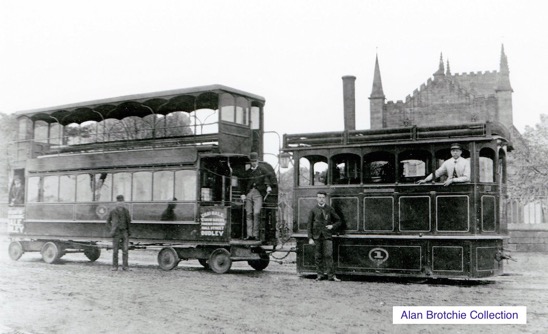
Kitson Steam Tram No 1 and Starbuck-built Trailer No 4 at the Wolverhampton terminus in Temple Street. The crests are that of the Dudley, Sedgley and Wolverhampton Tramways Company, and the engine appears to be in quite good condition, so the photo was in all probability taken between 1886 and 1889.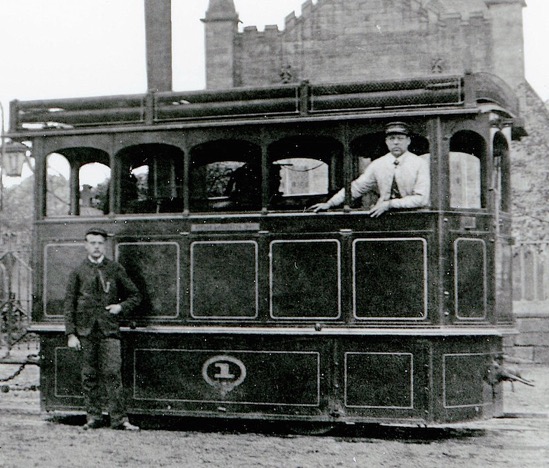
An enlargement of the above photograph showing the driver, in light-coloured cotton jacket and cap (without cap badge), and a man who is in all probability his stoker. 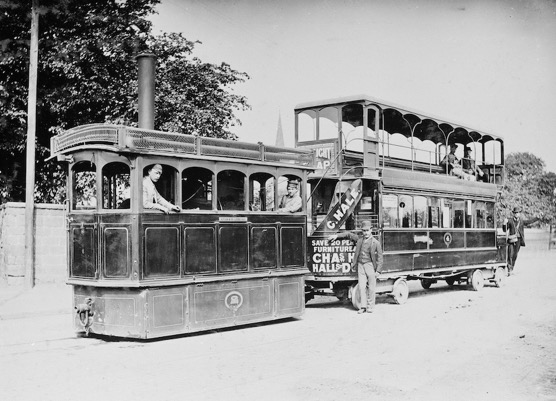
Steam Tram No 2 (a Kitson product) and Trailer No 4, this time captured in Sedgley near the Grand Junction public house. The crest is still that of the DS&WTCo, but this shot feels slightly later, possibly at the end of that company's tenure (i.e., 1889) or in the early days of the next incumbent, the Midland Tramways Co (1890). Photo courtesy of the National Tramway Museum.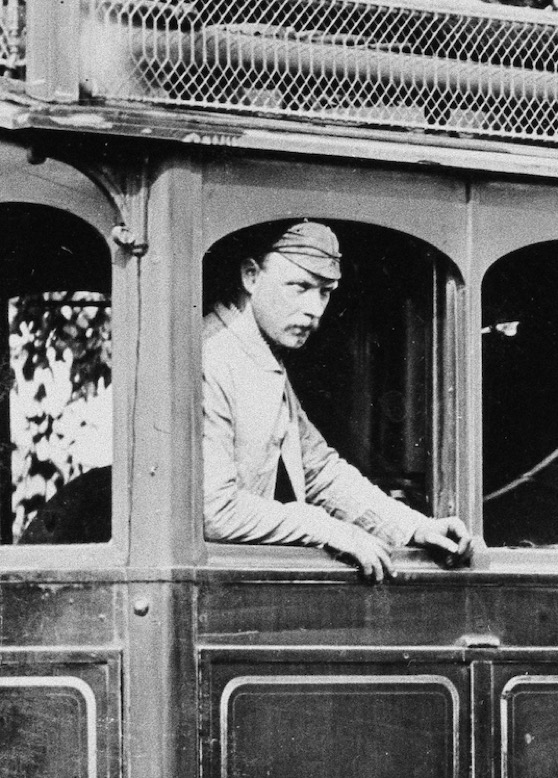
An enlargement of the above photograph showing the driver, in light-coloured cotton jacket and tight-fitting cloth cap.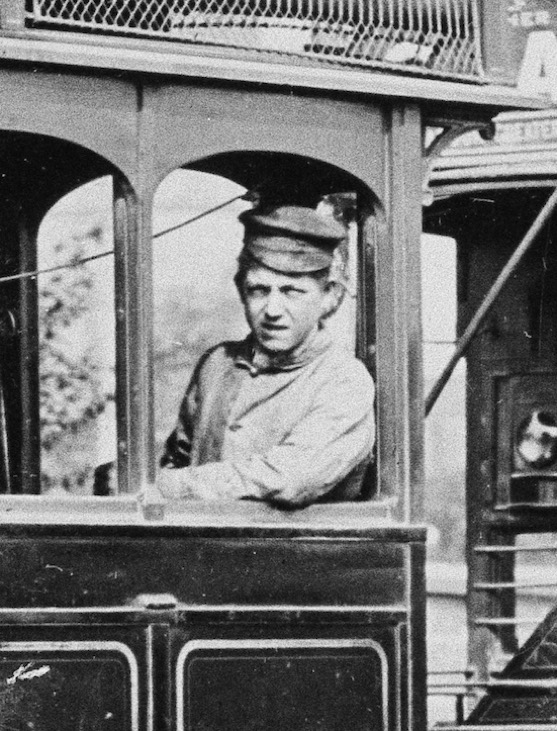
Another blow-up, this time showing the individual at the back of the engine, almost certainly the stoker, again in a light-coloured jacket, but wearing what would appear to be a grease-top cap.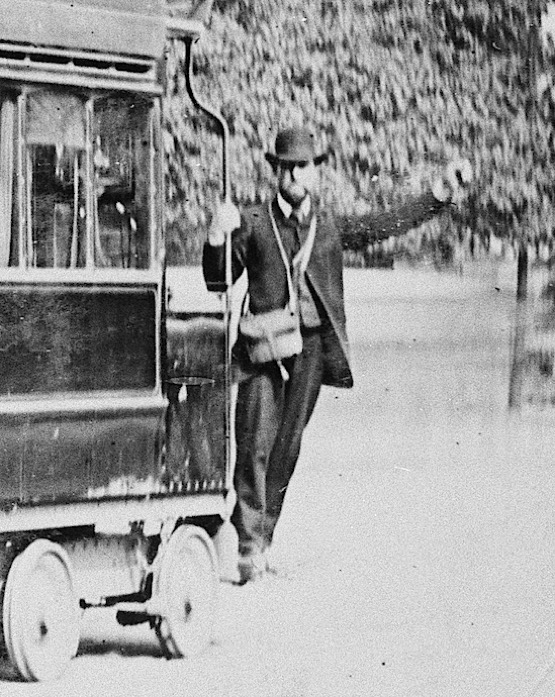
One last enlargement, unfortunately slightly out of focus, showing the conductor, who is clearly wearing smart yet informal attire; no badges or licences are in evidence.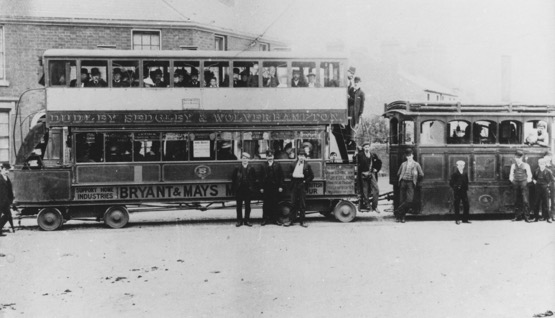
Kitson No 4 and enclosed Trailer No 5 at Fighting Cocks — photo undated, but probably taken in the mid-1890's. The conductor, who is standing on the trailer platform, is wearing informal attire. Author's Collection.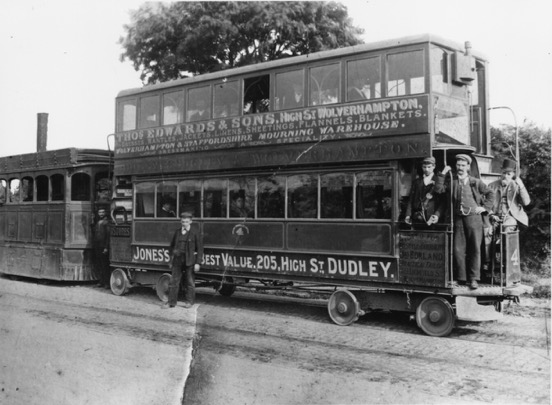
Steam Tram No 3 and Trailer No 4 (yet again) in the Springhead loop between Sedgley and Fighting Cocks — photo undated, but almost certainly taken in the mid-to-late 1890s (the crest is that of the Dudley and Wolverhampton Tramways Company'. By this time, the top deck sides of Trailer No 4 had been enclosed. The driver, who is just visible in the engine cab, is supposedly a Mr Thomas Horton. Photo courtesy of the Tramways and Light Railway Society, with thanks to David Voice.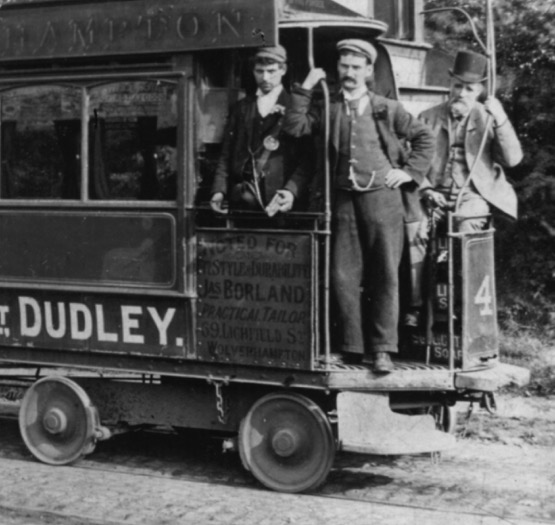
An enlargement of the above photograph showing the conductor (left), who is clearly in informal attire. Whilst the conductor appears to be wearing a municipal licence badge on his cash-bag strap, this may well be a ticket punch.
Senior staff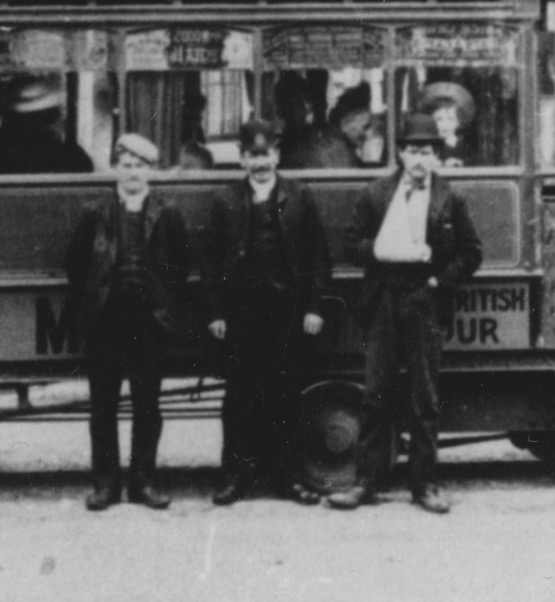
An enlargement of the Fighting Cocks photo above showing an individual who may well be an inspector; he is wearing a bowler hat with what would appear to be a tall, oval cap badge. Such badges were usually cloth, and were affixed to the hat by means of an elasticated band.